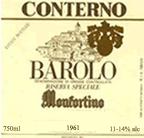1961 Barolo Red Blend
Giacomo Conterno Monfortino Monfortino is a captivating red blend from the esteemed Barolo region, showcasing the remarkable character of its 1961 vintage. This wine, with its deep ruby color, offers an alluring bouquet of dark fruit, dried herbs, and subtle earthy nuances, reflecting the complexity that comes with age. On the palate, it presents a full-bodied experience, supported by vibrant acidity and a delicate interplay of fine tannins that lend structure without overshadowing the nuanced flavors. The finish is long and elegant, expressing the wine's polished maturity while remaining thoroughly enjoyable. This Monfortino is a jewel, perfect for collectors and enthusiasts who appreciate the artistry of old-world winemaking.
Giacomo Conterno Monfortino Monfortino is a captivating red blend from the esteemed Barolo region, showcasing the remarkable character of its 1961 vintage. This wine, with its deep ruby color, offers an alluring bouquet of dark fruit, dried herbs, and subtle earthy nuances, reflecting the complexity that comes with age. On the palate, it presents a full-bodied experience, supported by vibrant acidity and a delicate interplay of fine tannins that lend structure without overshadowing the nuanced flavors. The finish is long and elegant, expressing the wine's polished maturity while remaining thoroughly enjoyable. This Monfortino is a jewel, perfect for collectors and enthusiasts who appreciate the artistry of old-world winemaking.




